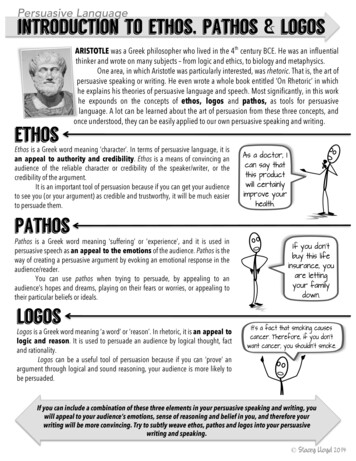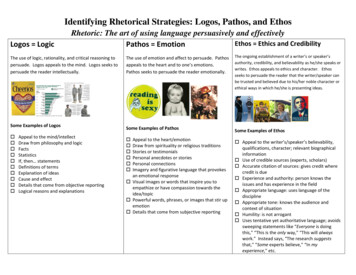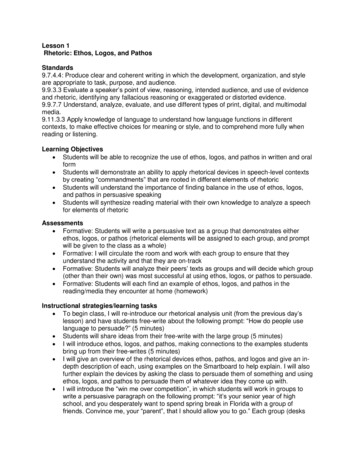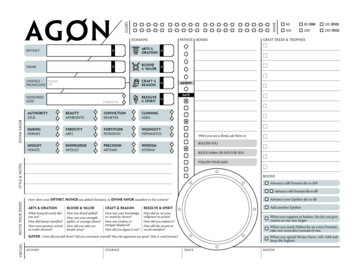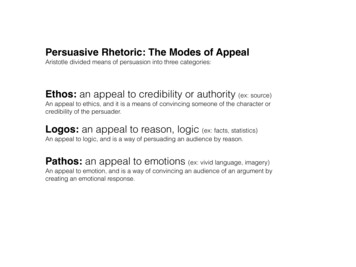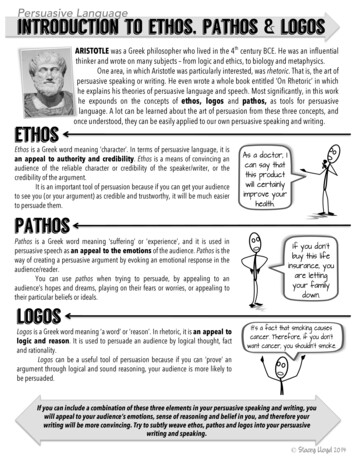
Transcription
Persuasive Languageintroduction to ethos, pathos & logosethosARISTOTLE was a Greek philosopher who lived in the 4th century BCE. He was an influentialthinker and wrote on many subjects – from logic and ethics, to biology and metaphysics.One area, in which Aristotle was particularly interested, was rhetoric. That is, the art ofpersuasive speaking or writing. He even wrote a whole book entitled ‘On Rhetoric’ in whichhe explains his theories of persuasive language and speech. Most significantly, in this workhe expounds on the concepts of ethos, logos and pathos, as tools for persuasivelanguage. A lot can be learned about the art of persuasion from these three concepts, andonce understood, they can be easily applied to our own persuasive speaking and writing.Ethos is a Greek word meaning ‘character’. In terms of persuasive language, it isan appeal to authority and credibility. Ethos is a means of convincing anaudience of the reliable character or credibility of the speaker/writer, or thecredibility of the argument.It is an important tool of persuasion because if you can get your audienceto see you (or your argument) as credible and trustworthy, it will be much easierto persuade them.pathosPathos is a Greek word meaning ‘suffering’ or ‘experience’, and it is used inpersuasive speech as an appeal to the emotions of the audience. Pathos is theway of creating a persuasive argument by evoking an emotional response in theaudience/reader.You can use pathos when trying to persuade, by appealing to anaudience’s hopes and dreams, playing on their fears or worries, or appealing totheir particular beliefs or ideals.logosLogos is a Greek word meaning ‘a word’ or ‘reason’. In rhetoric, it is an appeal tologic and reason. It is used to persuade an audience by logical thought, factand rationality.Logos can be a useful tool of persuasion because if you can ‘prove’ anargument through logical and sound reasoning, your audience is more likely tobe persuaded.If you can include a combination of these three elements in your persuasive speaking and writing, youwill appeal to your audience’s emotions, sense of reasoning and belief in you, and therefore yourwriting will be more convincing. Try to subtly weave ethos, pathos and logos into your persuasivewriting and speaking. Stacey Lloyd 2014
Ethos is anappeal toethics; it is ameans ofconvincingthe audienceof thecharacter orcredibility ofthepersuader.PERSUASIVE LANGUAGEHow can you incorporate ethos? You can openly remind your audience who you areand why you are an authority on the subject. (‘As theleading researcher, I agree ’). You can establish authority more subtly through theuse of jargon or specialized terms (‘My quantitativeresearch in linguistic anthropology has shown ’). You can establish credibility by just using correctgrammar and language, using solid reasoning andgood arguments and therefore sounding credibleand trustworthy.Why use ethos ?EXAMPLES:» I have been married for 58 yearsand I can tell you that he will notbe a good husband to you.» Having written ten successfulnovels myself, I can tell you thatthis book is worth buying.» My friend, who has a PhD innutritional science, says that weshould eat fewer carbohydrates.If your audience believe you to be a qualified, authoritative figure, or an expertin a subject, they are more likely to be persuaded by your argument.TASK ONE: For each of the following, identify whether or not ETHOS is used, and explain your reasoning.Ethos?“You should definitely get help with yourdebt, & I say that as somebody with over30 years experience of debt counseling.”“As your father, I love you and only want1 the best for you. Therefore when I askyou not to go, please listen to me.”YesExplainThe speaker is has referred to their extensive experience in thisarea, in order to give credit to their opinion. Somebody with over 30years experience would surely know what he or she is talking about .“We really should try that recipe.2 Someone told me that it was good.”“The research – conducted by professors3 at Harvard University – suggests that youshould learn a second language.“Dentists all over the world are telling4 their patients the same things. You mustfloss regularly.”“I read somewhere that bicarbonate of5 soda is really useful for cleaning. Youshould try it.”TASK TWO: For each of the following scenarios, write your own persuasive sentences using ethos:1. You are trying to persuade your mother to let you get a tattoo.2. You are attempting to convince an audience that animal testing is morally wrong.3. You are trying to persuade your teacher not to give you homework. Stacey Lloyd 2014
PERSUASIVE LANGUAGEHow can you incorporate pathos? You can use descriptive language and imagery,which evokes emotions. (‘This life-saving dishwasherwill enhance your life and lighten your load.’) You can identify values / emotions which relateparticularly to your audience, and play on them. (‘Iknow you care for your family, so ’) You can use personal stories to appeal to thesympathies and emotions of your audience. (‘When Ilost my job, I knew how important it was to )Why use pathos ?EXAMPLES:» If you don’t go on this holidayyou will regret it. You don’t wantto live with regrets, do you?» You love your dog; so buy thisdog food, as it will help him toget all his nutrients.» You have been poorly treated.You have been taken advantageof. Now is the time to take action.Pathos is anappeal toemotion; it isa means ofconvincingthe audienceby creatingan emotionalresponse.If your audience is emotionally invested and engaged with yourcause or argument, they are more likely to be persuaded.TASK ONE: For each of the following, explain how pathos is used (you must identify the emotional appeal).Explain“Don’t be the last person to get one.Here the speaker is appealing to the audience’s sense of pride by pointing out that they will beYou don’t want to be the laughing stock laughed at if they don’t get the product. This would make the listener/reader feel compelled to getof your school!”it, in order to maintain their dignity and not hurt their pride.“If you don’t purchase this life1 insurance, and something happens toyou, how will your family survive?”“We have been mistreated, abused and2 oppressed. They have benefited fromour suffering and we must act now!”“We live in a great democracy. So3 donate now and support the troopswho are protecting our freedom.”“Just eat and don’t complain. Children4 in Africa are starving and would giveanything to have that plate of food.”“Caring for the environment may not5 change your life, but it will change thelives of your children.”TASK TWO: For each of the following scenarios, write your own persuasive sentences using pathos:1. You are trying to persuade members of your class to volunteer to tutor underprivileged children.2. You are attempting to convince a friend to join your sports team.3. You are trying to persuade an audience that they should buy a particular brand of cereal. Stacey Lloyd 2014
PERSUASIVE LANGUAGELogos is anappeal tologic; it is ameans ofconvincingthe audiencethroughrationalthought andreason.How can you incorporate logos? You can use research and statistics to backup your arguments. (‘87% of students benefitfrom textbooks, so.’) You can use logical processes to explain yourpoint – ‘if this then that.’ (‘If you don’t wantgum disease, then you should brush regularly.’) You must give convincing, solid evidence andreasons to support your claims. (‘I need a car: itwould make me more independent; save memoney; improve my life.)Why use logos ?EXAMPLES:» I‘ve not eaten meat for 8 years, and I’mfit and healthy; you can’t argue thatvegetarianism is always unhealthy.» We have conducted the experiment 57times and we get the same results everysingle time.» That is not my wallet. My wallet has atear in it. This wallet has no tear in it.Therefore, it cannot be mine.If you can present a logical, rational argument to your audience, which engagestheir intellect and sense of reason, they are more likely to be persuaded.TASK ONE: For each of the following, explain whether or not you think that logos is being used effectively.Explain“I need new jeans. Everyone in myclass has new jeans.”This isn’t an effective use of logos as the reasoning is not logical and convincing. Firstly, it’s highly unlikely that everyone has new jeans (hyperbole). Secondly, just becauseother people have new jeans, it doesn’t logically follow that the speaker needs them.“All men and women will die. You are a1 man. Therefore, you will die one day.”“Everyone has children. Therefore,2 everyone needs to think about theschooling of his or her children.”“You don’t need to jump in front of atrain to know it’s a bad idea; so why do3 you need to try drugs to know if they’redamaging?”“Cigarette smoke contains over 4,8004 chemicals, 69 of which are known tocause cancer. So why start smoking?”“Every morning the rooster crows, then5 the sun rises. Therefore the roostercauses the sun to rise.”TASKTWO: For each of the following scenarios, write your own persuasive sentences using logos:1. You are trying to persuade your brother to stop eating chocolate.2. You are attempting to convince your class that they shouldn’t drink and drive.3. You are trying to persuade an audience that they should exercise more often. Stacey Lloyd 2014
PERSUASIVE LANGUAGE3 out of 4 people surveyed said that they prefer our brand to any other. If you careabout your teeth, make the wise choice and buy ShinyWhite before it’s too late.Pathos and Logos Stacey Lloyd 2014
PERSUASIVE LANGUAGEin advertisingFor each of the following extracts from advertisements, identify how ethos,pathos or logos is being used.SHINEYWHITE MOUTHWASH12 MACARONNI CHEESEJust the way mom makes it345 DynamiteSecurity6Recommended by dentists7 Stacey Lloyd 2014
TASK TWO: For each of the following scenarios, write your own persuasive sentences using pathos: 1. You are trying to persuade members of your class to volunteer to tutor underprivileged children. _ _ 2. You are attempting to convince a friend to join your sports team.

